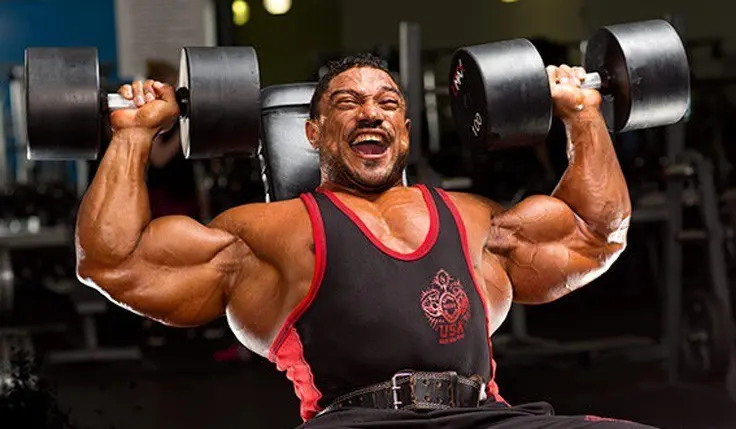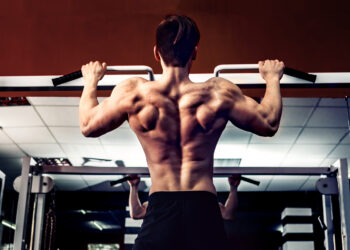The overhead press, a fundamental exercise in most lifting programs, not only develops the shoulders but also provides an array of benefits based on the variation chosen. Whether performed standing or seated, with barbells or dumbbells, each method has its unique advantages. With a multitude of choices before me in this Vs series, it’s crucial to delve deep into this ubiquitous exercise and understand its intricacies.
There are so many different ways I could go at this point. After covering the squat vs the leg press, the traditional vs the sumo deadlift, the pulldown vs the pull up and the bench press vs the dumbbell fly, the path in front of me feels literally wide open. This is because the lifts I’ve looked at thus far are the main lifts in any lifting program and now that I’ve covered those basics I can move on to some lesser used comparisons in this Vs series. Unless of course, I’ve neglected another very basic lift that every lifter does in one way or another, which is exactly what I’ve done. I’m of course talking about the overhead press.
Name me one training program that does not include some sort of overhead pressing. Didn’t think you could. From powerlifting, Olympic lifting, cross fit, every weight/exercise class I’ve ever seen and of course bodybuilding, all of the above rely heavily on some form of the overhead press to develop the shoulders amongst other things. If there is one exercise you need to do to increase your bench press, this is it. So where am I going with this with regards to the Vs series? I intend to look at the standing vs seated overhead press – dumbbell and barbell.
Overhead Press Muscle Activation Study
A study compared muscle activation during seated and standing overhead barbell and dumbbell presses. Fifteen trained male subjects performed 5 reps at 80% 1RM for each exercise while electrodes measured muscle activation.
The results showed standing overhead presses required more stability and activated more shoulder and arm muscle. Standing dumbbell presses activated the most anterior and posterior deltoid. Standing barbell presses activated the most middle deltoid, triceps, and biceps.
Level Up Your Fitness: Join our 💪 strong community in Fitness Volt Newsletter. Get daily inspiration, expert-backed workouts, nutrition tips, the latest in strength sports, and the support you need to reach your goals. Subscribe for free!
Seated vs Standing Overhead Press
Standing overhead presses activate more muscle but allow lower weights. Standing requires stabilizing the core and joints, decreasing how much weight can be lifted.
Seated overhead presses allow heavier loads but less muscle activation. The stable seated position shifts effort from stabilizers to the shoulders and arms.
If your goal is sheer strength, seated overhead presses enable heavier lifts. But for muscle growth, standing presses are superior.
Barbell vs Dumbbell Overhead Press
Dumbbells require more stabilization and activate more muscle. Separating the weights increases tension as each side works independently.
Barbells allow heavier weights but reduce stabilization demands. The fixed bar shifts effort from stabilizers to prime movers.
For strength, barbells enable heavier overhead presses. But for muscle growth, dumbbells activate more delts, biceps, and triceps.
Bodybuilding Benefits of Standing Overhead Presses
For sculpted shoulders, standing overhead presses are optimal. Here’s why:
- Full shoulder stimulation. Standing presses activate anterior, lateral, and posterior deltoids. Seated presses miss posterior activation.
- Increased muscle time under tension. The instability of standing forces muscles to work harder to stabilize joints.
- Core activation. Standing recruits abs and obliques to stabilize the spine and pelvis.
- Functional transfer. Standing mimics real-life overhead motions better than seated.
If your goals are defined shoulders and arms, standing overhead presses are superior to seated versions.
Overhead Press Form Tips
Proper form maximizes overhead press benefits while reducing injury risk:
- Brace core and glutes to stabilize spine. Do not arch lower back.
- Initiate press by driving feet into floor, not leaning back.
- Keep elbows pointed forward, not flared outward.
- Lower bar to just below chin, not to chest.
- Use full range of motion. Lock elbows at top without overarching.
- Keep shoulders down and back, not hunched.
- Breathe and brace core at the top, not the bottom.
- Use weight you can control for 3-4 sets of 6-10 reps.
Overhead Press Alternatives
Not ready for barbell or dumbbell overhead presses? Try these variations:
- Seated machine press – Supports core and stabilizes movement. Builds strength foundations.
- Push press – Uses legs to drive barbell upward. Reduces shoulder strain.
- Arnold press – Rotates palms from facing forward to facing you. Hits all shoulder angles.
- Dumbbell neutral grip press – Reduces wrist strain. A beginner-friendly alternative.
- Resistance bands – Accommodate limited mobility. Decrease joint stress.
The Results
The Anterior Deltoid EMG results:
- Seated barbell vs. seated dumbbell – muscle activation was 11% greater for the seated dumbbell press.
- Standing barbell vs. standing dumbbell – muscle activation was 15% greater for the standing dumbbell press.
- Seated dumbbell vs. standing dumbbell – muscle activation was 8% greater for the standing dumbbell press.
Middle Deltoid EMG results:
- Standing barbell vs. standing dumbbell – muscle activation was 7% greater for the standing dumbbell press.
- Seated dumbbell vs. standing barbell – muscle activation was 7% greater for the standing barbell press.
Posterior Deltoid EMG results:
- Seated barbell vs. standing barbell – muscle activation was 25% greater for the standing barbell press.
- Seated dumbbell vs. standing dumbbell – muscle activation was 24% greater for the standing dumbbell press.
Biceps Brachii EMG results:
- Seated barbell vs. seated dumbbell – muscle activation was 33% greater for the seated barbell press.
- Standing barbell vs. standing dumbbell – muscle activation was 16% greater for the standing barbell press.
- Seated dumbbell vs. standing dumbbell – muscle activation was 23% greater for the standing dumbbell press.
Triceps Brachii EMG results:
- Standing barbell vs. standing dumbbell – muscle activation was 39% greater for the standing barbell press.
- Seated barbell vs. standing barbell – muscle activation was 20% greater for the standing barbell press.
As far as the 1RM strength test was concerned, the standing barbell overhead press was 7% greater than the standing dumbbell overhead press and the seated barbell overhead press was 10% greater than the seated dumbbell overhead press.
Calculate Your One-Rep Max (1RM)
What do all of these numbers mean for you and I who are mostly concerned with building muscle and strength? It means that any form of standing press requires more stability which means that it will result in a lower 1RM, BUT the exercises that required the greatest amount of stability, meaning the standing barbell or dumbbell overhead press, required greater neuromuscular activity in the deltoids as well as the biceps and triceps brachii than did the seated version of both of the lifts.
This is somewhat of a surprise to me, but the clear winner as far as building muscle is concerned is both the standing barbell and dumbbell overhead press. It always made sense to me that when seated our core would have to do less work and therefore the shoulders would be able to do more, but this apparently is not the case. If a higher 1RM is your priority then the seated version is what you should focus on, but that is very few of us reading at this site. I know what I’m doing next shoulder day and the only thing I’ll be using the bench for is to rest between sets.
FAQ’s
Q: Is the overhead press essential for shoulder development?
A: Absolutely. The overhead press extensively activates the deltoids, making it a key exercise for comprehensive shoulder development.
Q: Which overhead press variation is best for core engagement?
A: Standing variations, whether using barbells or dumbbells, require more core stabilization, thus engaging the core muscles more.
Q: If I’m aiming for strength, which version should I focus on?
A: The seated barbell overhead press has shown superior results for those focusing on strength (1RM).
Conclusion
While the seated and standing overhead presses have their distinct advantages, the decision boils down to individual goals. Whether you prioritize muscle activation or strength will influence your choice. No matter your preference, integrating overhead presses into your routine is essential. So the next time you’re in the gym, choose wisely, and as always, happy lifting!
Happy Lifting!









